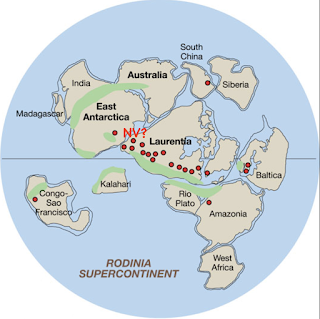 |
| Does the Siberian craton include part of Nevada? (source; text added). |
There are geologists who specialize in running plate tectonics backwards. Using a variety of evidence, they trace the paths of Earth's lithospheric plates to deduce earlier arrangements of continents. They've had some success. For example, there is general agreement that multiple smaller continents (like today) have alternated with a single or several supercontinents. But exactly how continents collided to become a supercontinent, and then how the supercontinent broke up and where the pieces went, are puzzles not easily solved.
A rift runs through it
In the late Proterozoic, roughly a billion to 700 million years ago, Earth's land masses were aggregated into a supercontinent named Rodinia (Russian for "homeland"). Then it broke up into multiple continents and terranes (smaller fragments). The ones that concern us here are Laurentia (predecessor of North America), Siberia (a separate continent then), and Eastern Antarctica.
 |
| A reconstruction of Rodinia about 900 million years ago (source); text added. |
Fortunately (for those of us who love such things), the Laurentian coastline is still with us, now called the "0.706 line". It was detected by analyzing many granitic igneous intrusions emplaced long after rifting. The rising magma passed through rocks dating from the time of Rodinia's breakup, and in the process, material from those rocks was assimilated, including two strontium isotopes—87Sr and 86Sr. This is helpful! In continental rocks, the ratio of the two isotopes is greater than 0.706; in seafloor rocks, it is less. So strontium ratios reveal where the late Proterozoic continent and seafloor met.
 |
| The 0.706 line (after Kistler & Ross 1990). |
Whither western Nevada?
Returning to the original question, where did the continental fragment west of the rift go? Since it was once continuous with eastern Nevada, surely it remains similar in some way—perhaps sharing the same rocks or geological structures. So have geologists wandered the world searching for a similar chunk of continent? Of course they have!
A leading contender resides in the Siberian craton in northeast Asia. The evidence is persuasive. The Sette Daban area of Siberia and the Death Valley area in southwest Nevada share "remarkably similar" sequences of Precambrian sedimentary rocks. In both locations, these "consist of five or six variegated siliciclastic-dolomite cycles that are each made up of numerous smaller cycles ..." (MacLean 2009). Similarity at such a fine scale is compelling.
Furthermore, fossils of the two areas are similar. Especially notable are the trilobites, which usually are limited in distribution. Shared types suggest the two areas were in close proximity. Geologic features are shared as well. Dike swarms and orogenic belts align nicely when the northeast margin of the Siberian craton is placed adjacent to western Laurentia (Sears & Price 1978).
 |
| Proposed reconstruction of Rodinia ~ 1 billion years ago (Sears & Price 2003). Shared orogenic belts underlined in red ("NV?" also added). |
But of course if we rule out Siberia, we must return to our original question. Where is Proterozoic western Nevada—where did that rifted fragment go?!
Maybe Antarctica?
Goodge et al. (2008) think they've found it in East Antarctica, which is composed largely of Precambrian craton fragments, including rocks not unlike those buried in eastern Nevada. They also cite a boulder (found in a moraine) of a somewhat unusual granite—Type A or rapakivi. It is similar to a zone of rapakivi granites that crosses North America/Laurentia, dated at ~1.4 billion years.
 |
| Rodinia 750 million years ago; red dots are ~1.4 Ga rapakivi granites (Goodge et al. 2008) ("NV?" added). |
Next question
While the plate reconstructionists haven't yet answered our question as to whither, we do know that Proterozoic western Nevada is gone. Furthermore, the growing ocean that separated it from Laurentia has disappeared too. So what makes up western Nevada now? Stay tuned.
Sources
 |
| Pine Nut metavolcanics in western Nevada—a traveler come to rest. |
Sources
DeCourten, F. 2003. The Broken Land; adventures in Great Basin geology.
DeCourten, F and Biggar, N. 2017. Roadside Geology of Nevada.
Goodge, JW, et al. 2008. A positive test of East Antarctica-Laurentia juxtaposition within the Rodinia supercontinent. Science 321, 235–240.
Kistler, RW, and Ross, DC. 1990. A strontium isotopic study of plutons and associated rocks of the southern Sierra Nevada vicinity. USGS Bull. 1920.
MacLean, JS, et al. 2009. Detrital zircon geochronologic tests of the SE Siberia-SW Laurentia paleocontinental connection, Stephan Mueller Spec. Publ. Ser., 4, 111–116, https://doi.org/10.5194/smsps-4-111-2009
Piper, JD. 2011. SWEAT and the end of SWEAT: the Laurentia–Siberia configuration during Meso-Neoproterozoic times. Int. Geol. Review 53.
Sears, JW, and Price, RA. 1978. The Siberian connection: A case for the Precambrian separation of the North American and Siberian cratons: Geology 6: 267–270.
Sears, JW, and Price, RA. 2000. New look at the Siberian connection: No SWEAT. Geology 28.
Sears, JW, and Price, RA. 2003. Tightening the Siberian connection to western Laurentia, Geol. Soc. Am. Bull. 115.
Nice!
ReplyDeleteThanks, Richard. Nice to hear from you :)
DeleteNot about Nevada, but i wanted to tell people about how beautiful the Capitol Reef area is right now. I just was there for a few days with people who hadn't seen that country before. Hello to Mr Richard Gibson, in honor of our shared moniker.
ReplyDeletenice ... maybe we've come full circle now?
Delete